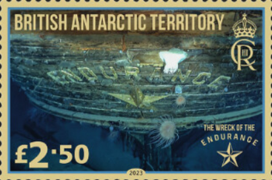04 December 2024
|
On 5 November, the postal administrations of the British Antarctic Territory, Falkland Islands and South Georgia & the Sandwich Islands released a joint tribute to commemorate the efforts of Ernest Shackleton and the crew of Endurance.
Stamp Collectors can read more in the latest issue of Stamp including Coin Collector magazine.
In 1914, Ernest Shackleton and his 28-man crew, including photographer James Francis “Frank” Hurley, set sail in Endurance on an expedition to cross the Antarctic continent. However, by 1915 they were lost and stranded; forced to camp on the ice for five months. Eventually, Shackleton made two open boat journeys, including a treacherous 800-mile ocean crossing to South Georgia Island, which is now considered one of the greatest boat journeys in history.
The Endurance ship was rediscovered in the icy waters of Wendell Bay, Antarctica, in 2022. It took ten years and two expeditions, but on 5 March 2022, with the support of the Falklands Maritime Heritage Trust, Sir Ernest Shackleton’s ship, Endurance, were finally found, making headlines around the world. The wreck was located beneath the ice of the Weddell Sea at a depth of 3,008m, in an area Shackleton called the ‘worst portion of the worst sea on earth’.
The commemorative stamps marking this incredible story of survival were designed by Robert Maude and Sarah Davies using Hurley’s original photographs. The Royal Geographical Society (with the Institute of British Geographers) owns the copyright to some of the photographs, as does the Scott Postal Research Institute, University of Cambridge.
Suggest article: 54th Asiago Awards 2024
The first expedition, in 2019, chartered the 12,900-ton icebreaker, SA Agulhas II, and an Autonomous Underwater Vehicle (AUV) was used to survey the seabed. The search ended when ice conditions deteriorated and the AUV disappeared without trace. When the quest resumed on the same ship in 2022, they succeeded in finding the Endurance. A ‘Sabertooth’ unmanned submersible, made by Saab of Sweden, was the main search vehicle. It was linked to the surface by up to 6km of fibreoptic cable, which meant the team could follow the in-coming data stream in real time.

The wreck was discovered upright, semi-intact and in an excellent state of preservation. Even its paintwork was still visible. The masts were down, and the ice had destroyed the deck house and most of the quarterdeck, but the well deck at the stern was untouched. The ship’s wheel was in position and largely unscathed, as was the binnacle, or wooden stand in front of the wheel, which held the vessel’s magnetic compass.
Most remarkable was the fact that the Endurance had been found exactly 100 years to the day after Shackleton had been buried on South Georgia. Through the Sabertooth’s cameras, the team saw Shackleton’s cabin and the ship’s name across the stern over the emblem of the North Star, or Polaris, after which the ship had originally been named. The Polaris had been built at Sandefjord, Norway, in 1911–13. In 1914, it was bought by Sir Ernest Shackleton, who renamed it Endurance after his family motto ‘by endurance we conquer’. The ship was to carry his team to Antarctica, where it was his intention to cross the continent from the Weddell Sea to the Ross Sea by way of the Pole. But it was not to be.
On 18 January 1915, without having reached their destination of Vahsel Bay, the Endurance became icebound. For ten months, Endurance was carried northwards by the icepack, until on 21 November 1915, the hull ruptured, and the ship plunged to the seabed. For over five months, Shackleton and his team of 27 survived on the ice. On 9 April 1916, they took to their three boats and, after six days, they made Elephant Island. Shackleton then took the 22-foot-long James Caird and five of his men and departed for South Georgia to seek help. It took over two weeks to reach their destination where, after nine days of recuperation, Shackleton and two of the crew set off over the island’s mountainous spine for the whaling stations on the other side.
After they turned up at Stromness 36 hours later, rescue attempts then began to rescue the remaining 22 men on Elephant Island. After a failed attempt at rescue with a small whaling steamer, further attempts were made, but it was not until 30 August 1916, that Shackleton finally got through and rescued them all using a Chilean naval tug, the Yelcho, under the command of Lieutenant Luis Pardo. All of those on the expedition survived. It was a story of extraordinary leadership, courage and determination. Some have called it the greatest escape – ever.
Stamp collectors can learn more about stamp stories from around the world in Stamp Stories, Volume one.







